Creating a Fake Plagiarism Story
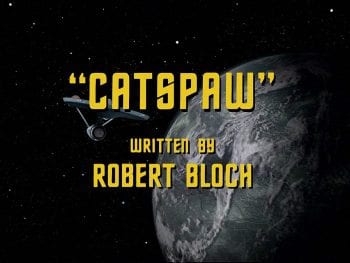
As a fan of both Star Trek and The Rocky Horror Picture Show, it pains me to say that I’ve found “irrefutable evidence” that the Rocky Horror was plagiarized in no insignificant part from a lesser-known episode of Star Trek: The Original Series.
The episode, Catspaw, first aired on October 16, 1967, a full six years before the Rocky Horror Show, the precursor to the film, made its debut in 1973.
In Catspaw, an away team, seeking to find out what happened to the previous away team, find themselves stranded on a remote planet in the midst of a violent storm. They then make their way to an isolated castle to find shelter and find themselves captive to an eclectic man named Korob and his colleague Sylvia.
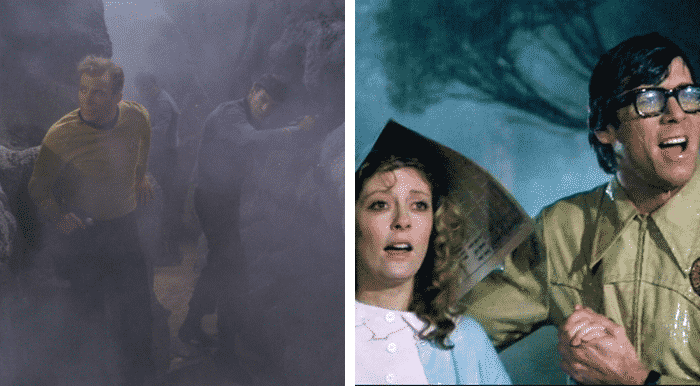
Korob uses some form of mind control to take over the both the original away team and Doctor McCoy. They then reveal themselves to be aliens from a distant galaxy who alter matter with their minds. Their captors force them to eat with them and eventually Sylvia becomes angry at Kirk and Spock and disapproves of how Korob is handling them. As a result, she turns on Korob, crushing him under a door and attempting to kill Kirk and Spock.
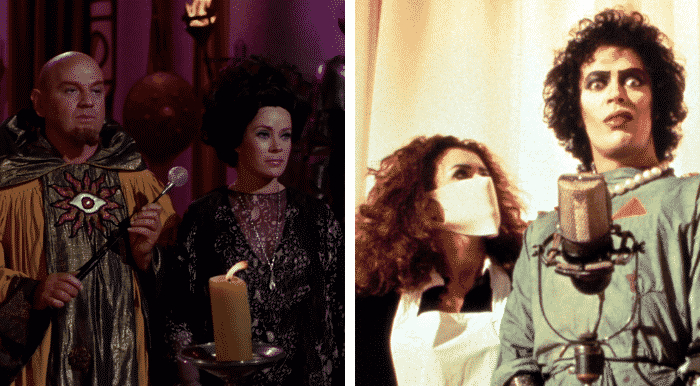
However, Kirk is able to grab the transmuter and smash it, causing the castle to disappear.
RHPS, on the other hand, features two protagonists, Brad and Janet, trapped in a horrible storm. They too find their way into a castle where they fall under the spell of an eclectic Dr. Frank-N-Furter. Frank-N-Furter, who is also an alien from a distant galaxy, uses a transducer (so close to transmuter) to manipulate matter. Just as in Catspaw, Brad and Janet are forced to eat dinner with their captors, even as tensions among them grow.
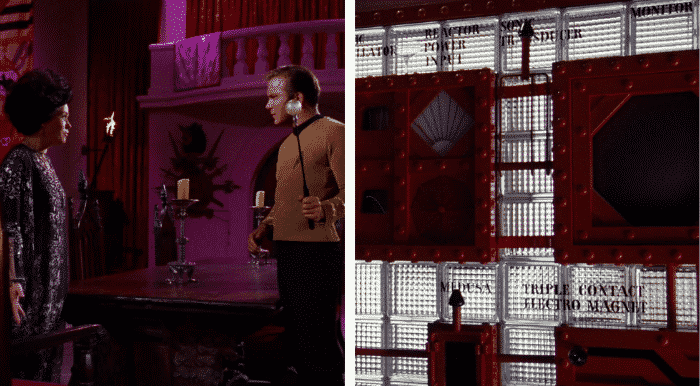
Frank-N-Furter is likewise betrayed by his associates, Riff Raff and Magenta, who grow tired of Frank-N-Furter’s ways and, after killing him, the castle disappears though, in Rocky Horror, it is beamed back to their home planet.
The similarities between the two are simply too great to ignore. I postulate that the only way that the similarities can be explained is that Richard O’Brien, the creator of Rocky Horror, must have plagiarized Catspaw. The similarities are simply too great and too specific to ignore.
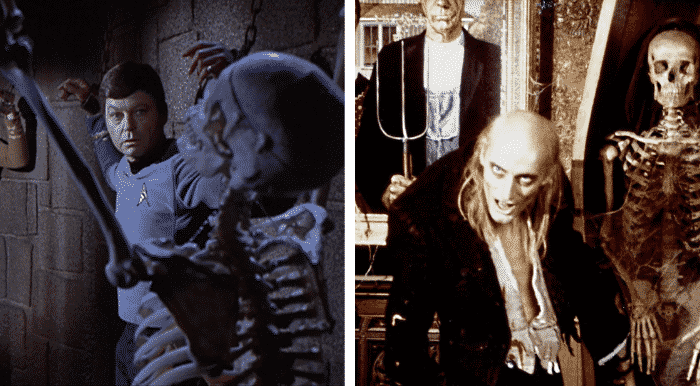
This is, of course, complete malarkey. Though everything I said about the movie and the episode is factually accurate, Rocky Horror is not a plagiarism of Catspaw.
Though the two certainly had some similarities, it’s because both are playing off of the same tropes, specifically haunted house tropes and science fiction tropes common to that time. Furthermore, the “analysis” was carefully written to ignore any differences between the two (like the entire rest of the Rocky Horror cast and plot) and even the images took some creative cropping.
But the fact that some could construe the above as actual proof of plagiarism says a great deal about how we perceive originality, coincidence and plagiarism.
Set Plagiarism Detectors to Stun
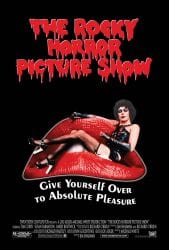
Note: Even though I’m referring to these as false or fake plagiarism stories, the accusers are rarely insincere. The point of this exercise is to show how easy it is to see plagiarism where none exists, not to accuse people of lying.
While the above plagiarism theory was meant to be silly and in good fun, there have been many “serious” plagiarism stories built upon similar compilations of facts.
Whether it’s a controversy over The Shape of Water, the fan-made accusations over the movie Repo Men or the recent lawsuit over Star Trek: Discovery, similar comparisons have been the genesis of much more serious plagiarism allegations.
And it’s hard not to get caught up in it. Even as someone who listens to plagiarism allegations all day, it can be easy to be drawn in by these types of comparisons.
This is because, as humans, we are hard-wired to spot patterns. To do that, we take new information and compare it to things we are familiar with. For example, as someone who has seen Rocky Horror over 100 times, it was natural that I would see the similarities between it and Catspaw when I viewed it for the first time in over 20 years.
However, as psychology has come to understand, those patterns are often false. The term for seeing patterns in otherwise meaningless data is apophenia and it is considered a basic psychological trait in all of us.
If my familiarity had been with a different set of movies, in particular classic horror movies, I undoubtedly would have seem similarities between Catspaw and those films. Likewise, the episode had deliberate similarities to H.P. Lovecraft that could have been spotted.
However, since my core familiarity was with Rocky Horror, I saw those patterns and that resulted in more than a few callouts during a Star Trek episode.
In this case, it was harmless fun. Other times, as we’ve seen above, it’s taken a much more serious turn.
Recognizing False Plagiarism Stories
There’s no simple solution to separating the false plagiarism stories from the real ones. It’s made all the more complicated by the fact that, sometimes, these comparisons to pan out. Such is the case of the Instinct/Bones plagiarism controversy earlier this year.
The secret, is to not get caught up in pattern recognition and, instead, look at the similarities objectively.
To that end, ask yourself a series of questions:
- Is Plagiarism Even Possible? Many cases, such as the aforementioned Shape of Water plagiarism case and the Dennis The Menace story, can be dismissed out of hand simply because plagiarism wasn’t physically possible. If neither author had access to the other’s work, plagiarism isn’t possible.
- Is There a Common Source? Other times, two works can seem to be very similar because they are pulling from a common source. In the example above, Catspaw and Rocky Horror are both pulling from tropes related to classic horror and b-movie science fiction. Whether it’s common tropes, real world inspiration (as with Star Trek: Discovery) or other common sourcing can explain a lot of similarities.
- Can The Similarities Be Coincidence? Though coincidence can be something difficult to prove, it has to be considered. If two characters named Dennis The Menace can appear in separate comics on the same day without plagiarism, then it must be considered as a possibility in other cases.
The latter is one of the more difficult ones to wrestle with. With verbatim text plagiarism, we actually know, with some degree of certainty, the approximate chance something was a coincidence. Given the number of words in the English language, their frequency of use and the topic at hand, we can make a solid estimate on how likely coincidence is.
When dealing with ideas and plot points, it gets more difficult. What separates a case like Repo Men from Instinct isn’t just the number of similarities, but the specificity and uniqueness of them.
Instinct, for example, copied even very small details from Bones, including lines of dialogue, specific visuals and very targeted plot points. With Repo Men, it was exclusively about the big idea with other similarities being unoriginal to the works involved.
The same is true for Rocky Horror and our deliberately fake plagiarism story. None of the similarities are unique to the movies involved and it’s impossible to say that A was copied from B, especially given much of the similarities are tropes both were intentionally playing off of.
However, even with all of those questions answered, there is still one more…
What are the differences between the works?
It’s easy to believe a work is plagiarized when looking at just the similarities, but you have to look at the differences as well. With Catspaw and Rocky Horror, there are many.
Catspaw is a fairly stock and trade episode of Star Trek: The Original Series dealing with the philosophical issues that come with absolute power. Rocky Horror, on the other hand, is a musical with themes of sexual liberation and references to B movies and classic Hollywood.
They are fundamentally very different works and the similarities they share are not specific to the works themselves. It’s not a case of plagiarism, but it is remarkably easy to frame it as if it were one.
Bottom Line
When reading allegations of plagiarism, especially when it involves ideas, themes, plot points, etc., it’s important to listen with a critical ear. Don’t just look at the similarities, look at where those similarities likely came from and also focus on the differences.
Often times, it’s nearly impossible to be certain what is or is not plagiarized. As frustrating as that is, it’s important to be certain when making accusations.
Still, it’s difficult to overcome the way our brains operate. We are programmed to spot patterns, even when none exist, and that will continue to plague the conversation around plagiarism for as long as there is such a conversation.
Want to Reuse or Republish this Content?
If you want to feature this article in your site, classroom or elsewhere, just let us know! We usually grant permission within 24 hours.
